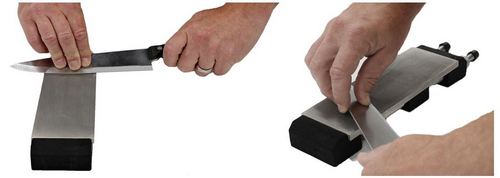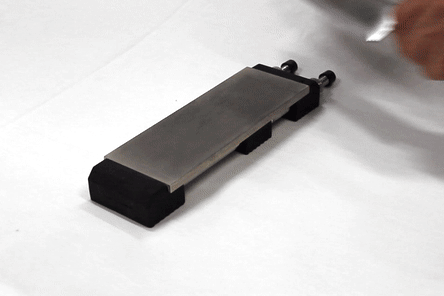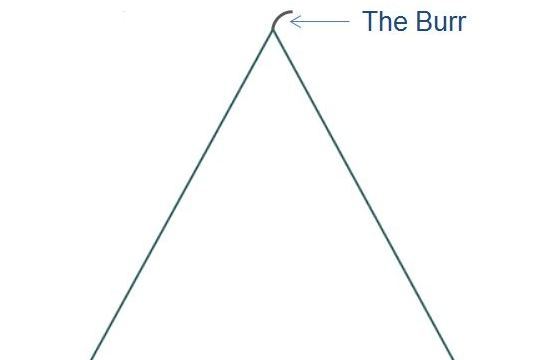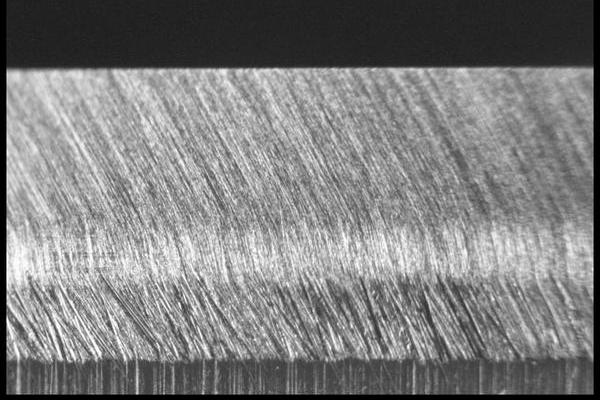How to Use a Sharpening Stone


- Tools Required
- Sharpening Geometry
- Knife Anatomy
- Creating the Burr
- Refining Your Edge
- Testing for Sharpness
- Types of Sharpening Stones
- Sharpening Stones Grits
- Using an Angle Guide
- Why use a stone
- Summary
There are several ways to sharpen with a stone. The purpose of this article is to provide a tried-and-true method that anyone, regardless of experience can use to sharpen a knife with a stone.
Using a sharpening stone is a very easy skill to master. It takes a little practice and a little patience but you can learn this valuable skill quicker than you imagined.
Whether you're learning how to sharpen kitchen knives, pocket knives or sporting knives this article will teach you how.
Before we get into the two steps of sharpening let's take a quick look at the tools you'll need.
Tools Required
- A Sharpening Stone - Which sharpening stone you use is a personal choice but I strongly suggest beginners use a diamond stone. A diamond stone removes metal much faster than other abrasives and you'll be able to see your progress more quickly. The various stone types are explained in more detail below.
- A Sharpening Stone Holder - A sharpening stone holder is an inexpensive yet valuable tool. It holds your stone firmly in place while sharpening and also provides the needed knuckle clearance you need.
- Lubricant - It is imperative that your stone remain well lubricated during the sharpening process. If using a diamond stone use Krud Kutter or glass cleaner as a lubricant. If using a water stone use water, and if using an oil stone I recommend mineral oil.

Knife Edge Geometry
Simply put, a perfect edge is created when two planes of equal size and dimension intersect at a point forming an apex. Sharpening a knife is nothing more than creating those two planes.
Think of sharpening as grinding. You are really just grinding away metal until you have created two intersecting planes and an apex if formed.
One of the most common mistakes made is not grinding away enough metal to form the Apex. You need to keep grinding until you have removed enough metal to form a point where the two planes intersect.

A quick look at knife anatomy before we get started sharpening.
Knife Anatomy

Ok, let's get started sharpening.
How to Sharpen with a Stone
We are going to break this down into two steps. Step 1 will be Creating the Burr and Step 2 will be Refining the Edge.
The important thing to remember is to maintain a consistent angle and apply even pressure while passing the blade over the stone. It's really that simple. With a little practice you'll be an expert in no time. Remember: Consistent Angle + Even Pressure = A Sharp Edge.
STEP 1: Creating the Burr:
The burr is simply a very fine wire of metal that is pushed over the edge to the other side of the knife.

The easiest way to be sure you have removed enough metal is to create a burr. Creating a burr is nothing more than grinding on one side of the blade until it intersects with the other side.
Raising the burr while sharpening a knife is an important step. When you can feel the burr you will know you have created a plane on one side of the knife.
It is important to raise the burr along the entire length of the blade. Be sure you can feel the burr along the full length of the edge before proceeding. Raising the burr correctly now will save you a lot of time in the long run.
1. Lay the blade across the knife and raise the back of the knife to establish your desired angle. The best angle is 20 to 25 degrees for most knives. There are free apps for both the iPhone and Android that make it very easy to determine your sharpening angle. The one I have is called "Bubble Level" and there are several others available. You can also buy a digital angle gauge that has a magnet and will stick to your blade.
2. Firmly grasp the knife handle in one hand and place your fingers and a thumb on the blade as shown below. When pulling the blade towards you, your fingers will be lightly grasping the spine of the blade and your thumb will rest on the blade. When pushing the blade away from your body, your thumb and finger positions will be reversed. Move the blade across the stone while holding a consistent angle and applying even pressure. Use a slight sweeping motion to be sure you are working the full length of the blade.

Sharpening Motion
3. Draw the blade across the stone on the first side 10 times. Turn the knife over and draw the blade across the second side 10 times. Continue switching from side to side while performing 10 strokes on each side until you can feel the burr on one side of the knife. (The reason we are only doing 10 strokes on a side before switching over is if we only ground one side until we felt the burr we would end up with a lopsided edge.)

4. You can test for the burr with your fingernail. Run your fingernail from the spine (top) of the blade towards the edge you are sharpening. The burr will catch your fingernail as you run it off the edge. Be sure you have created the burr down the full length of the blade from heel to tip.

Now, let's refine the edge and finish up.
STEP 2: Refining the Edge:
Now that you have created the two intersecting planes, it's time for refinement.
We are going to basically do the exact same thing we did in step one above except we are going to alternate sides on every stroke.
Draw the blade across the stone on the first side 1 time. Turn the knife over and draw the blade across the second side 1 time. Continue switching from side to side while performing 1 stroke on each side until the edge has your desired sharpness.
How to Test for Sharpness:
There are many ways to test and edge for sharpness but the easiest way I know of is to slice a piece of plain copy paper. The paper should slice cleanly without hanging up. Hold the paper firmly in one hand.
Beginning about 3 inches from the corner, slice the paper to a spot about three inches on the opposite side of the corner. The other popular way to test for sharpness is to shave a little hair off your arm. This is a good test if you don't mind having bald spots on your arm. Also, for most kitchen knives the edge does not need to be sharp enough to shave hair. The paper test is best.

Stropping on leather is a technique favored by many but it can have it drawbacks and even dull your knife if not done correctly. I don't encourage those new to sharpening to use a leather strop in the beginning. Sharpening and stropping use different (although similar) motions and I would rather someone new to sharpening master the technique of sharpening before moving onto stropping.
Types of Sharpening Stones:
There are four basic types of sharpening stones; diamond stones, Arkansas stones and water stones. It is really a matter of personal preference which stone to use. In the last ten years diamond stones have rapidly increased in popularity and today they are the most popular stones used to sharpen both knives and tools. The main advantage of a diamond sharpening stones is that it removes metal much more quickly than other types of stones and that's what sharpening really is; the process of removing metal. Still, some people love Arkansas stones and would use nothing else, others prefer diamonds stones and others water stones. Here is a brief summary of the three types of stones:
-
Diamond Stones
- Remover metal approximately 10 times faster than other abrasives
- Size Range: 2x6" and 3x8"
- Available in grits from 120 to 8000
- Hardest abrasive available and will sharpen all types of steels and even ceramic knives
- Do not need to be maintained or flattened
- Last a very long time.
-
Arkansas Stones
- Natural stones quarried in the USA
- Comprised of quartz
- Available in four grits; Coarse, Medium, Fine, Extra-Fine
- Remove metal more slowly than diamond or water stones but last a very long time
-
Water Stones
- Wide range of quality and price available
- Size Range: Almost all waterstones are approximately 3" wide and 8" long
- Available in grits from 120 to 30,000
- Wear faster than diamond or Arkansas stones and need to be flattened often
- Beware of cheap water stones, they are very soft and wear quickly. We recommend you stick with a quality brand like Pride Abrasives, Shapton or Norton.
Sharpening Stone Grits
Sharpening stone grits are an important aspect of using a sharpening stone and I want to talk briefly about them here.
Sharpening stone grits range from 50 to 30,000.
In general, a higher grit number represents a smaller particle size that will produce a finer edge. A lower grit number indicates a larger, coarser particle size. The grit number represents the number of particles per square inch.
In practical terms, grit is the number of abrasive particles that can pass through a screen with specific size openings. A 100 grit abrasive particle will pass through a mesh screen that has 100 openings per inch. (This definition is generally accepted but the values are approximate. The thickness of the wire used to make a specific screen will vary the number of openings in one square inch of that specific screen.) The term "grit" more accurately identifies the particle size distribution but the difference in terminology is insignificant for industry purposes.
The most popular grit sizes used are approximately 300, 600 and 1200 grit. The 1200 grit is by far the most popular grit size sold. This is an all-purpose grit and is commonly referred to as extra-fine. The 600 grit is also a very popular size but will not leave your edge as finely refined as the 1200 grit. If you only want to buy one stone we suggest staying in the 1000-1200 grit range. Both diamond and water stones are available in this grit range. The Hard Arkansas stone also fits in this grit range.
If you want to further refine your edge, you can use a higher grit stone and continue with the sharpening technique described in Step 2 above. Diamond stones are available in 2200, 4000 and 8000 grits. Water stones are commonly available in grits all the way up to 30,000 and Arkansas stones are available in approximately 2000 and 4000 grits.
It is important to point out that for sharpening kitchen knives or pocket knives there is little benefit to using a grit higher than 6000. At this grit level the apex is well formed and you will be able to comfortable shave with your knife.
The three images below give you an idea of what the various scratch patterns look like for various grits. The knife in the first image was sharpened on a 600 grit diamond stone. The knife in the second image was sharpened on a 1200 grit diamond stone and the third image shows a knife sharpened on 14000 grit lapping film. If you've never seen these kinds of images before the first two might seem a little rough but don't let the images fool you, the blades in all of these images will shave hair.



Free Hand or Angle Guided?
There are several types of angle guides available that can be used to sharpen a knife with a sharpening stone. Using an angle guide helps a beginner learn to hold the knife at a consistent angle and develops the muscle-memory needed to sharpen with a stone.
We recommend the angle guides from Razor Edge for holding a consistent angle - Razor Edge Sharpening Angle Guides. I have a set of Razor Edge Guides I have been using for about 10 years and they are still going strong. After sharpening several knives with an angle guide you may find you no longer need them. It's kind of like when we learned to ride a bike with training wheels. Although I primarily freehand sharpen, I still use them when I get a knife that is in very bad condition and I need to establish a new bevel from scratch. It makes the job quicker and it's much easier than freehand when a lot of steel needs to be removed.
Why Sharpen with a Stone?
- Sharpening with a stone is the easiest and fastest way to keep your knives and tools sharp. It is much easier and faster to simply take a stone out of a drawer, place in on a counter top and begin sharpening. The set-up time is about 10 seconds.
- A good sharpening stone set is fairly inexpensive as opposed to a decent knife sharpener that can cost hundreds of dollars.
- Using a sharpening stone is an easy skill to learn
- Maintain a consistent angle and even pressure
- The tools needed are a stone, stone holder and lubricant
- The most common mistake is not removing enough metal
- The best all-purpose stone is a 1200 grit diamond sharpening stone
We always welcome feedback about our articles. For feedback, suggestions or comments please Contact Us.

